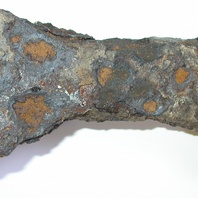
Viking Objects
Iron Axe-head (1989-58/3296)
Axes were not only a common implement used for a variety of wood based activities, such as constructing ships, but also were often used as weapons. Axes came in a variety of shapes and sizes depending on their function. This one was made to be a weapon and would have been wielded with a single hand. It was found at Repton in Derbyshire where there was a Viking camp which was recorded in the Anglo-Saxon Chronicle under the year 873/4.
Read More
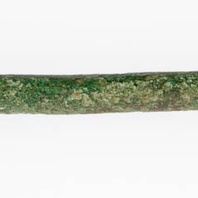
Viking Objects
Copper-Alloy Needle (CM. 1845-2008)
A cylindrical copper-alloy needle fragment with a broken shaft. Needles were a common textile tool and could be made from bone, metal or wood. They are usually associated with women and finds like this indicate that the inhabitants of the Viking camp at Torksey included women and children alongside the warriors of the Great Heathen Army.
Read More
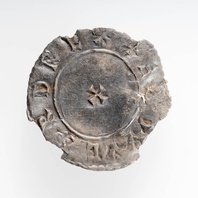
Viking Objects
Edward the Elder Penny (CM.616-1998)
A silver Horizontal type (HT1) penny of Edward the Elder (c. 874-924) minted in London by Garead. Edward was the son of Alfred the Great and succeeded him as king of Wessex. This coin was part of a hoard of twelve coins found at Thurcaston between 1992 and 2000. The coins are Anglo-Saxon, Arabic and Viking issues, and show the diverse and wide-ranging contacts between societies at this time. The hoard was probably deposited c.923-925, approximately five years after Leicester had been retaken by Mercia (c.918). They indicate that a bullion economy was still operating in the Danelaw as late as the 920s. This suggests that the reconquest did not manage to institute Anglo-Saxon practices such as a monetary economy immediately.
Read More
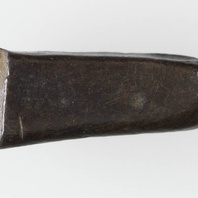
Viking Objects
Silver Ingot (CM.1789-2008)
This silver ingot was made by melting down worked silver cast into a rod and cut into sections. The Vikings arriving in England had a bullion economy where they paid for goods with silver that was weighed to an amount agreed between the buyer and the seller. Hacksilver and silver ingots are the most common evidence for their bullion economy. It took some time for the Scandinavian settlers to adopt a monetary economy like that of the Anglo-Saxons, and both systems were used simultaneously for a while before they fully adopted the new system. They were familiar with monetary economies but they treated coins as just another form of silver before adoption of a monetary economy.
Read More
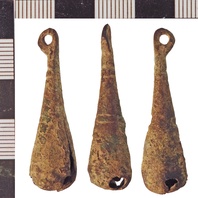
Viking Objects
Harness Bell (NLM-5EFFAE)
This medieval copper-alloy harness bell has changed little from the type that would have been familiar in the Viking Age. They were used alongside other ornaments to decorate harness. This one is made from a sheet of folded metal and still contains the small pea that would have made a noise when the horse moved.
Read More
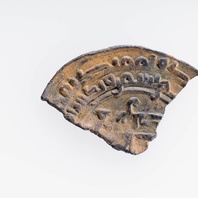
Viking Objects
Samanid Dirham Fragment (CM.840-2002)
This is a silver dirham which was minted during the reign of the Samanid ruler Akhmad Ibn Ismail (907-14) or Nasr ibn Ahmed (914-43) in Samarkand. The dirham was a unit of weight used across North Africa, the Middle East, and Persia, with varying values which also referred to the type of coins used in the Middle East during the Viking Age. These coins were extremely prized possessions not only for their silver value but as a way of displaying ones wealth, status, and vast trade connections. Millions of Arabic Dirhams would have been imported throughout the Viking world and are mostly found in hoards. Arabic coins are especially useful for dating sites, because they carry the date when they were minted. This permits precise dating where the part of the coin with the date survives, whereas European coins can only be dated to the reign of the ruler depicted on them. In western descriptions of these coins, the Arabic dates found on the coins are usually listed in square brackets, as above, and the European equivalent is listed after it. This coin was part of a hoard of twelve coins found at Thurcaston between 1992 and 2000. The coins are Anglo-Saxon, Arabic and Viking issues, and show the diverse and wide-ranging contacts between societies at this time. The hoard was probably deposited c.923-925 CE, approximately five years after Leicester had been retaken by Mercia (c.918 CE). They indicate that a bullion economy was still operating in the Danelaw as late as the 920s. This suggests that the reconquest did not manage to institute Anglo-Saxon practices such as a monetary economy immediately.
Read More
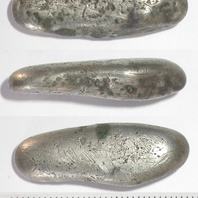
Viking Objects
Breedon Silver Ingot (X.A236.2009.0.0)
A Viking silver ingot which could have been used as bullion in payments or trade transactions, as well as a source of metal for jewellery making. The Vikings arriving in England had a bullion economy where they paid for goods with silver that was weighed to an amount agreed between the buyer and the seller. Hacksilver and silver ingots are the most common evidence for their bullion economy. It took some time for the Scandinavian settlers to adopt a monetary economy like that of the Anglo-Saxons, and both systems were used simultaneously for a while before they fully adopted the new system. They were familiar with monetary economies but they treated coins as just another form of silver before adoption of a monetary economy.
Read More
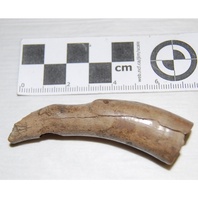
Viking Objects
Zoomorphic Knife Handle (L.A67.1864.2.0)
This bone knife handle was carved into the head of a dragon with the snout broken off. This handle is typical of the sorts of small knives that people carried for everyday use in the Viking Age. They would have been worn suspended from a belt or hung from a brooch. As general utility knives, they would have been used for everything from eating to trimming one’s nails.
Read More
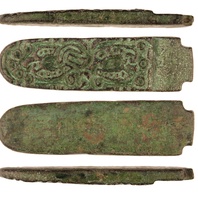
Viking Objects
Jellinge Style Die (LCNCC:1999.27)
This copper alloy metalworker’s die was used for manufacturing decorated pressblech foils. It features an intertwined zoomorphic design in the Jellinge style which was a popular Scandinavian style in the tenth century.
Read More
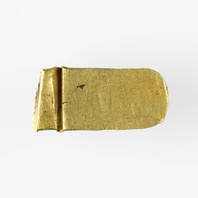
Viking Objects
Hack-gold (CM.1800-2008)
This rounded ingot terminal was cut from a larger rectangular ingot. Though rarer than hacksilver, this gold ingot formed part of the bullion currency used by Vikings in England and may be associated with their winter camp in Torksey.
Read More
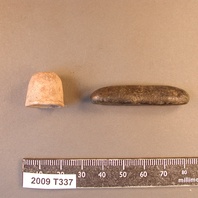
Viking Objects
Breedon Silver Ingot (X.A208.2010.0.0)
A cast silver ingot of typical Viking type. The photograph shows it alongside a lead gaming piece of a type that is increasingly being found within the Danelaw. This ingot could have been used as bullion in payments or trade transactions, as well as a source of metal for jewellery making. This particular ingot has slight irregularities from being made in an open mould and has two testing nicks on one edge. The Vikings arriving in England had a bullion economy where they paid for goods with silver that was weighed to an amount agreed between the buyer and the seller. Hacksilver and silver ingots are the most common evidence for their bullion economy. It took some time for the Scandinavian settlers to adopt a monetary economy like that of the Anglo-Saxons, and both systems were used simultaneously for a while before they fully adopted the new system. They were familiar with monetary economies but they treated coins as just another form of silver before adoption of a monetary economy.
